Lecture 5
Part A: Identifying User Stories and Use Cases
重点:
User Story的模板,需要注意的是什么,什么样的模板,以及它的Acceptence Criteria
User Case, use case discription
User goal technique和Event decomposition technique之间的区别是什么,它们分别是怎么做的
在Event decomposition中Types of Events这三种不同的event是什么,以及区别
Events 和 Sequence of Prior Conditions and Responses 这两个之间的区别是什么
User Stories
A User Story is a one-sentence description of a work-related task done by a user to achieve some goal or result
Suitable in Agile development 适用于敏捷开发
- Less formal than UML diagrams

Acceptance Criteria identify the features that must be present at the completion of the task
验收标准确定任务完成时必须具备的特征
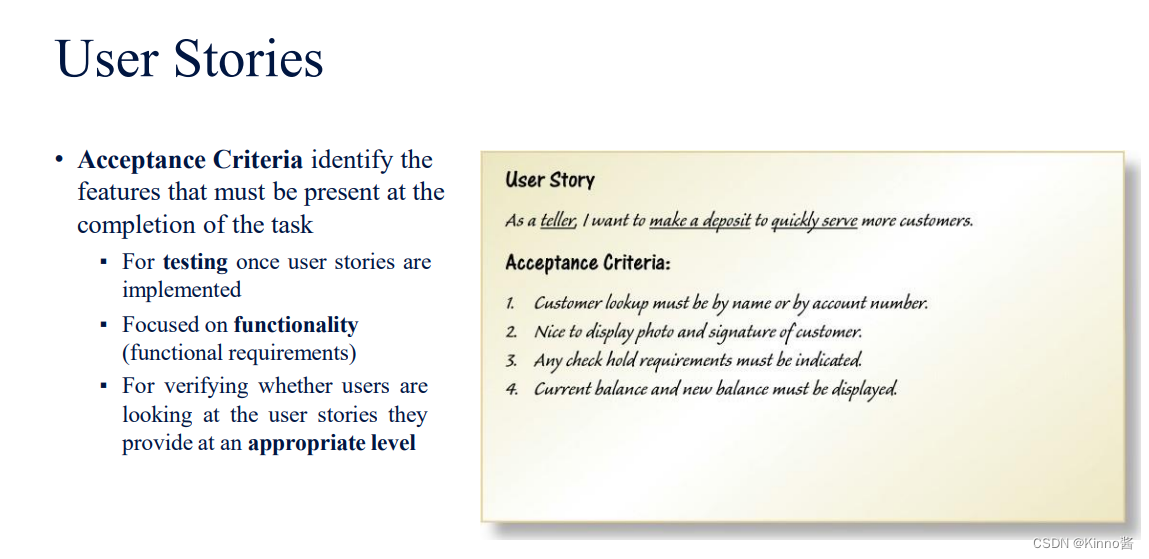
The acceptance criteria can be used to generate test data.

Use case
Use case: an activity that the system performs, usually in response to a request by a user
- More formal than user stories

这两个之间的区别是什么?

1.User Goal Techniques(去鉴定它的goal是什么)
一种确定用例的技术,通过确定系统必须为用户完成哪些具体目标或目的。
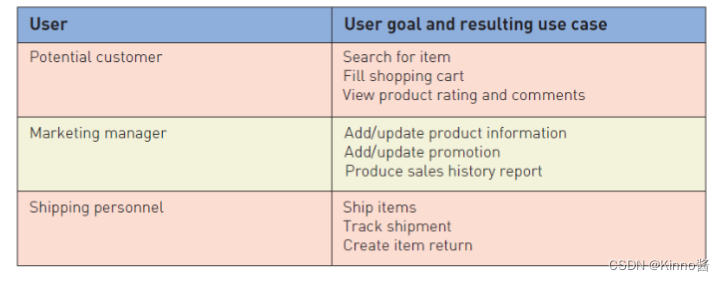
Specific Steps:
- Identify all the potential users for the new system
- Classify the potential users in terms of their functional role (e.g., shipping, marketing,
sales) - Further classify potential users by organisational level (e.g., operational, management,
executive) - For each type of user, interview them to find a list of specific goals they will have when
using the new system - Create a list of preliminary use cases organised by type of user
- Look for duplicates with similar use case names and resolve inconsistencies
- Identify where different types of users need the same use cases
- Review the completed list with each type of user and then with interested stakeholders
2.Event Decomposition Technique 把use case分解去鉴别3种不同的event类别
Elementary Business Processes (EBP)
A most fundamental task in a business process that is performed by one person in one place in response to a business event, adds measurable value, and leaves the system and its data in a stable and consistent state.
业务流程中最基本的任务,由一个人在一个地方对业务事件作出反应,增加可衡量的价值,并使系统及其数据处于稳定和一致的状态。
Specific Steps:
- Consider the external events in the system environment that require a response from the system, and identify and name the use cases考虑系统环境中需要系统响应的外部事件,并识别和命名用例
- Consider the temporal events that require a response from the system, identify and name the use cases 考虑需要系统响应的时间性事件,识别并命名用例
- Consider the state events that the system might respond to, and identify and name the use cases and then define the state changes 考虑系统可能响应的状态事件,并确定和命名用例,然后定义状态变化
Types of Events 三种不同的event以及他们的区别
-
External Event: an event that occurs outside the system, usually initiated by an external agent or actor ⎼ a person or organisational unit that supplies or receives data from the system 发生在系统外的事件,通常由外部代理或行为者发起 ⎼ 从系统中提供或接收数据的人或组织单位
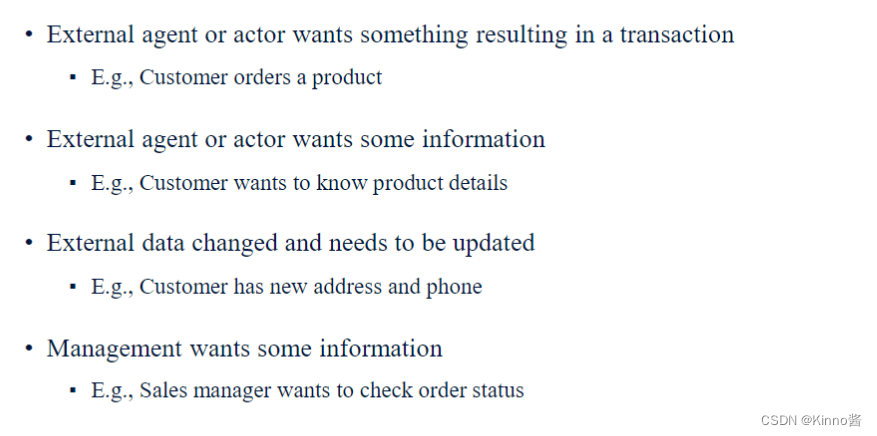
-
Temporal Event: an event that occurs as a result of reaching a point in time 由于到达某个时间点而发生的事件
- different from external events in that the system should automatically produce the required output without an actor

- different from external events in that the system should automatically produce the required output without an actor
-
State Event (Internal event): an event that occurs when something happens inside the system that triggers some process 当系统内发生某种情况,触发某种进程时发生的事件。
- Often, state events occur as a consequence of external events 通常,状态事件是外部事件的结果
- State events may be similar to temporal events but the point in time cannot be defined 状态事件可能类似于时间事件,但无法定义时间点


不,它是在完成原始交易时发生的互动的一部分
Events 和 Sequence of Prior Conditions and Responses 这两个之间的区别是什么
要区分它到底是event还是只是某一个需要去做的结果(一个response)
如何鉴别和区分

Project Schedule Management
Project schedule management processes
- Planning schedule management
- Defining activities
- Sequencing activities
- Estimating activity durations
- Developing the schedule
- Controlling the schedule
Network Diagrams
Two main formats
- Activity-on-arrow (AOA) or Arrow Diagramming Method (ADM)
- Precedence Diagramming Method (PDM)
Arrow Diagramming Method (ADM)
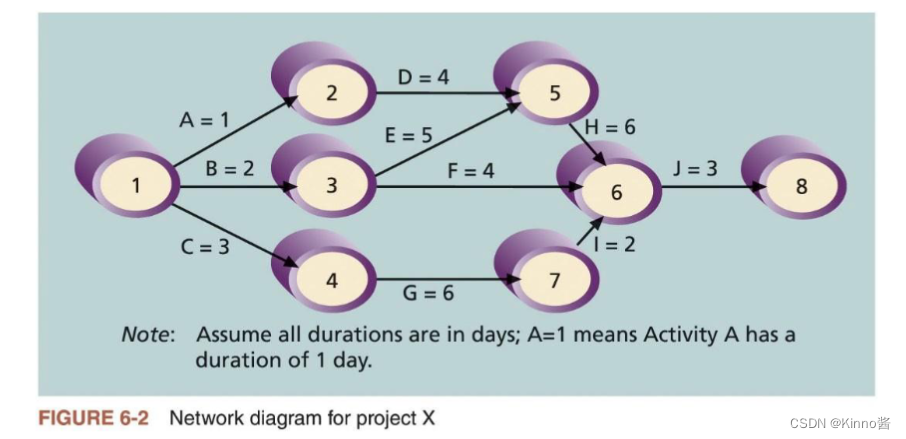
Look for bursts and merges.
- Bursts occur when two or more activities follow a single node.
- A merge occurs when two or more nodes precede a single node.
Precedence Diagramming Method (PDM)
nodes represent activities
Types of dependencies or relationships between activities
• Finish-to-start
• Start-to-start
• Finish-to-finish
• Start-to-finish
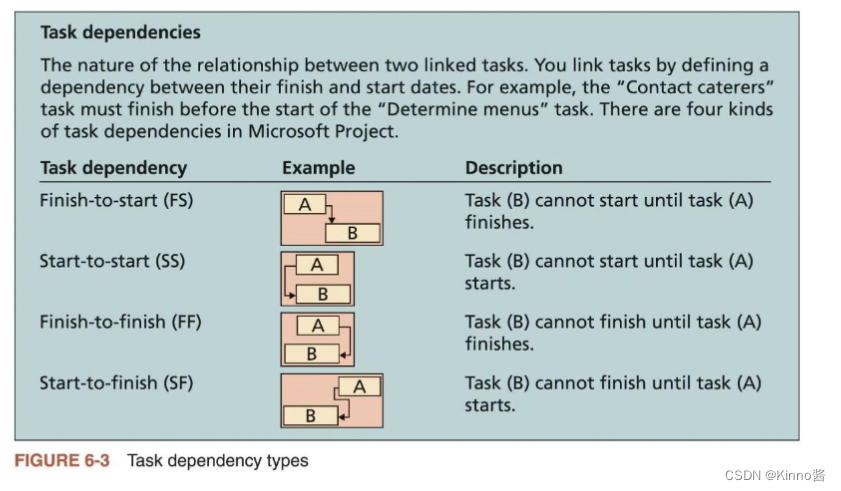
Developing the Schedule
Important tools and techniques
• Gantt charts
• Critical path analysis
• PERT analysis
Gantt charts
Symbols
• Black diamond: milestones
• Thick black bars: summary tasks
• Light gray horizontal bars: durations of tasks
• Arrows: dependencies between tasks
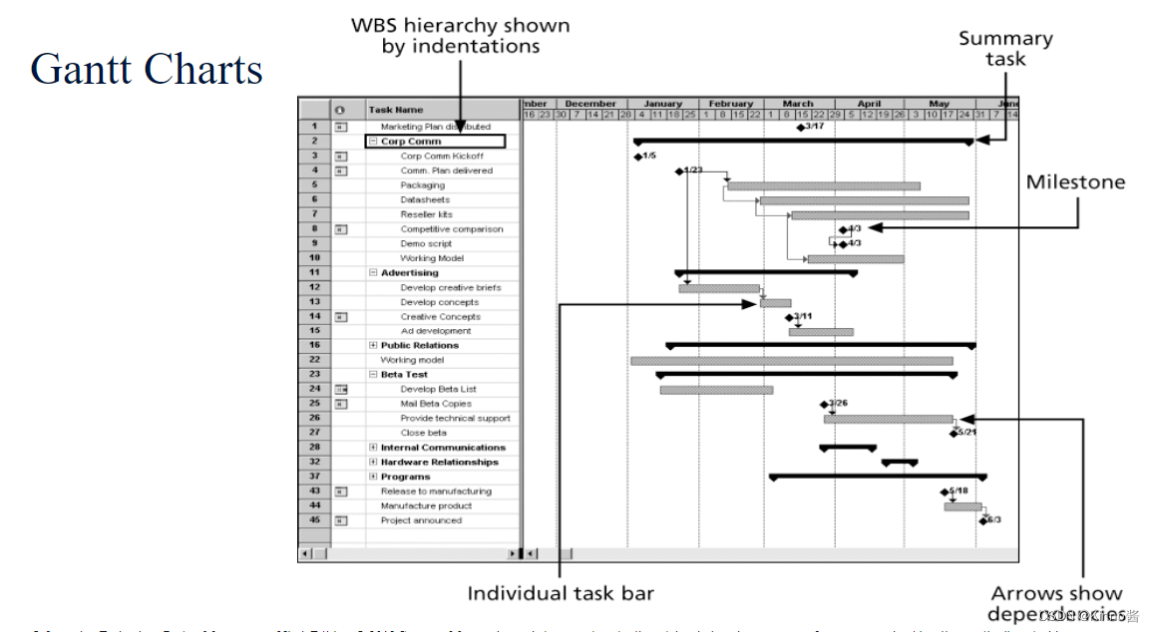

Critical Path Method
series of activities that determine the earliest time by which the project can be completed 确定项目最早完成时间的一系列活动
Longest path is the critical path
Using Critical Path Analysis to Make Schedule Trade-Offs
最早开始时间(Early Start,简称ES)
最早结束时间(Early Finish,简称EF)
最晚开始时间(Late Start,简称LS)
最晚结束时间(Late Finish,简称LF)
总浮动时间[亦称为总时差](Total Float):TF = LF-EF,又被称为总时差。它代表了在不影响项目总体进度的前提下,活动可以延误的时间段;
自由浮动时间:(Free Float)FF(活动X)=后续活动的ES - EF(活动X)-1。它代表了该活动不影响后续活动而可以被延误的时间。
注:
- 总时差Total slack or total float是每个活动历时可以延误的范围,并且可以不影响总体项目的进度.[一项活动在不推迟计划的项目完成日期的情况下,可以从其早期开始推迟的时间量。]
- 自由浮动Free slack or free float时间是指在不延误任何活动最早开始的情况下,项目活动可以延误的时间范围[在不耽误任何紧随其后的活动的提前开始的情况下,一项活动可以推迟的时间量。]
- Forward pass: Determines the early start and finish dates 上侧:确定最早的开始和结束日期
- Backward pass: Determines the late start and finish dates 下侧:确定最晚的开始和结束日期
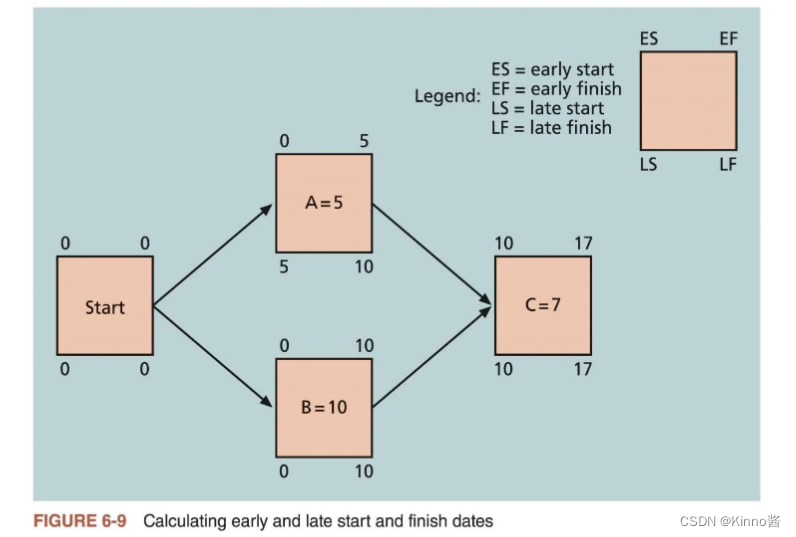
**How many days extra can Task G take without affecting the finish date of the project?**在不影响项目完成日期的情况下,Task G 可以多花多少天?

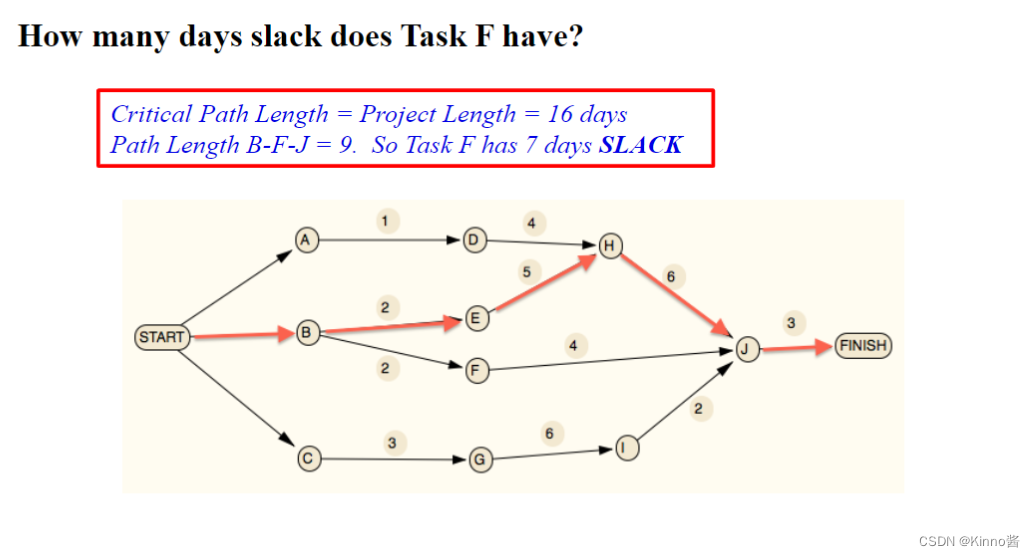
Program Evaluation and Review Technique (PERT)
optimistic, most likely, and pessimistic time

three-point estimate
A three-point estimate is an estimate that includes an optimistic, most likely, and pessimistic estimate
• Three-point estimates are needed for PERT analysis
Time Management Matrix
Important
Urgent
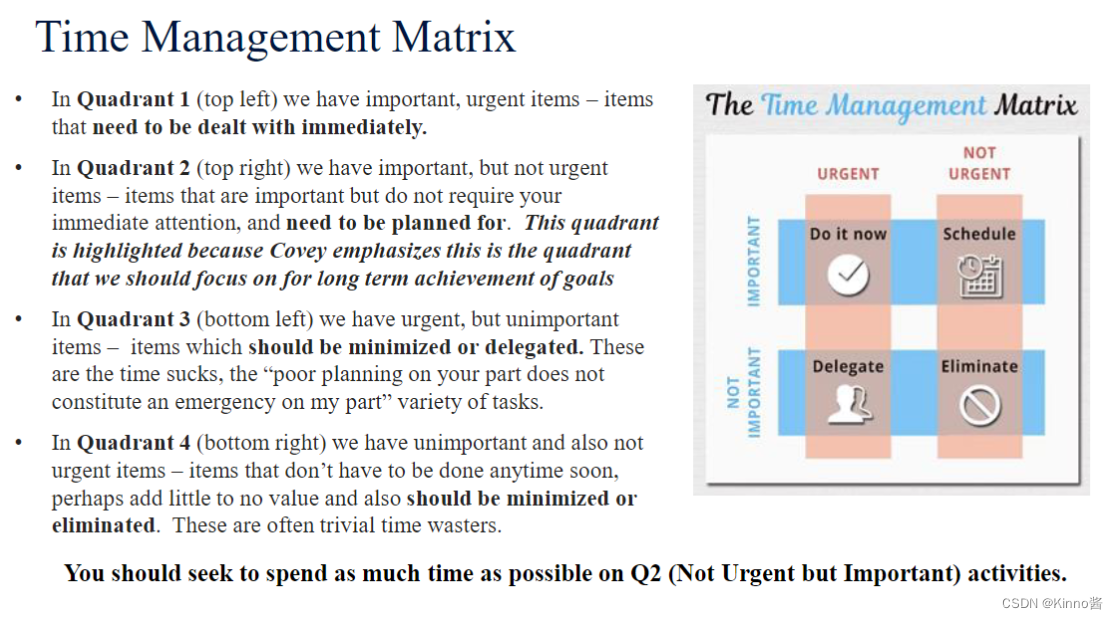






















 3920
3920











 被折叠的 条评论
为什么被折叠?
被折叠的 条评论
为什么被折叠?








